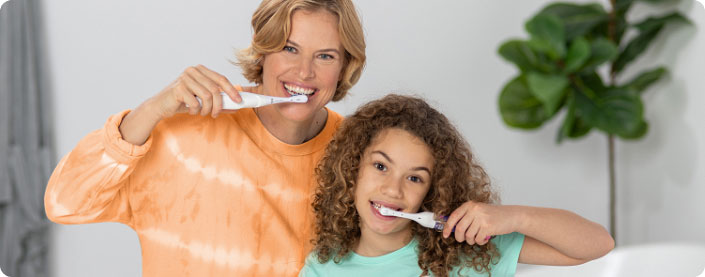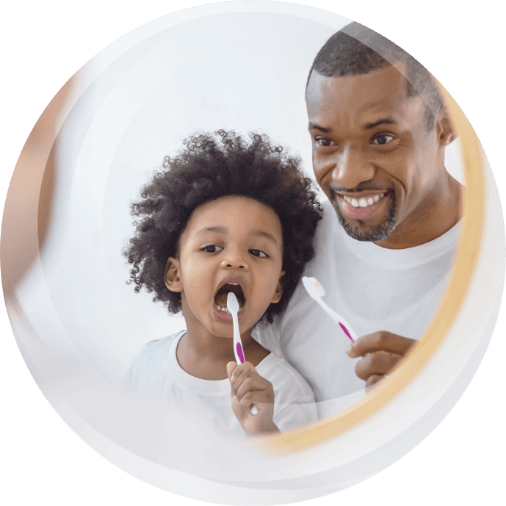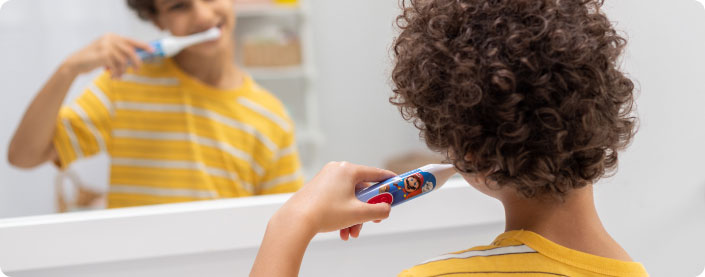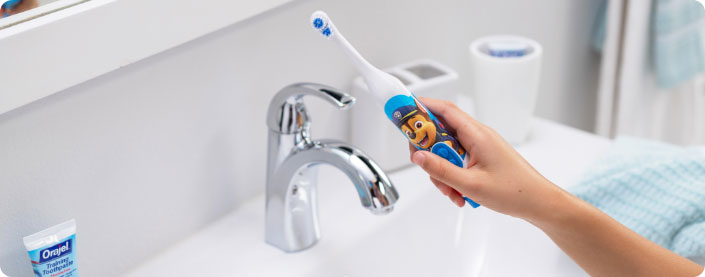How to Choose a Kids Toothbrush
Getting your kids to brush their teeth is easier when they are invested in the process—and allowing them to choose a toothbrush they love and will use willingly is a big part of that process. It’s important to get a toothbrush that is made for kids. Children’s mouths and teeth are shaped differently than adults, and it can be genuinely uncomfortable for a child to use an adult toothbrush.
When choosing a kids’ toothbrush, look for:
- Properly sized head. Toothbrushes have age suggestions based on the average size of a kid’s mouth at that age. Pay attention to those guidelines to get a brush that is sized correctly for your child.
- Bristles. Toothbrushes for kids should have soft bristles that won’t irritate tender gums. If a child feels that the toothbrush hurts, they will resist brushing.
- Shape of the handle or grip. Make sure your child can easily hold the toothbrush and that it feels comfortable in their hand – whichever hand they primarily use.
- Color or fan affiliation. Choosing the color, or a brush with their favorite character, will help them want to use it. Spinbrush™ offers an array of toothbrush products that can appeal to the different ages and stages your children go through, including:
- Recommended by American Dental Association. The ADA stamps a seal of acceptance on toothbrushes that meet its standards for good oral hygiene. Look for the seal on the toothbrush packaging.
- Electronic or manual? You want to teach your children proper brushing techniques, and that includes mastering circular and back-and-forth strokes. Sometimes an electric toothbrush can help your kid learn proper brushing—and be fun to use at the same time. Electronic brushes might have spinning heads to help remove plaque or they may play a song, vibrate, or use lights to help kids brush for the full two minutes. Additionally, electric toothbrushes remove up to 70 percent more plaque vs. manual toothbrushes in hard-to-reach places, helping your kids get a thorough and effective cleaning.
- Lifespan. Toothbrushes wear out and need to be replaced regularly to continue to be effective at cleaning your teeth. Dentists recommend every 3 or 4 months, or sooner if the bristles become frayed. When they are frayed or splayed outward from use, it’s time for a new toothbrush. A worn-out toothbrush doesn’t do an effective job of cleaning teeth. Some toothbrushes come with indicators on the bristles or handles to help you know when it’s time to replace them. Inspect your toothbrush’s bristles regularly. Pay attention to whether the spinning brush is disposable, or if you can replace the heads or the batteries.
Remember, offering your kids optionality and making the selection process fun can help encourage them to brush their teeth. Spinbrush™ electric toothbrushes help to ensure you are choosing a brush that can provide effective cleanings to keep your kiddo’s teeth clean, with fun character connections they’re sure to love!
How to Choose a Kids Toothpaste
The toothbrush is only half the process. You also need to get a toothpaste your kids will love to use, but don’t love so much that they want to eat it as a snack. While toothpaste should be refreshing in your mouth, it isn’t great to swallow it.
When choosing a kids’ toothpaste, consider:
- Type of packaging. Some toothpastes for kids are in tubes while others are in standing tubes or pump dispensers. You’ve heard the adage about once toothpaste is out of the tube, you can’t put it back in. Which packaging will be easiest for your kids to use and result in the least amount of mess and waste?
- Flavor. While most adults enjoy minty fresh toothpaste, mint can be too strong or “spicy” for most kids. That’s why you’ll see milder flavors that appeal to kids, such as bubble gum or strawberry. Don’t worry, though. Just because they are named for a candy, or a sweet fruit doesn’t mean they are packed with sugar. Your kid may be fooled, but you can rest assured the toothpaste is removing sugar, plaque, and food debris, not adding it.
- Fluoride or no-fluoride. Most dentists recommend a fluoride toothpaste for daily use after your child is age 2 or above. However, some parents are concerned about too much fluoride, especially if they live in an area where tap water is fluoridated. Both fluoride and fluoride-free formulas are available.
- Other ingredients. If your child is sensitive to food dyes and additives, you’ll want to pay attention to artificially colored toothpastes and read labels carefully.
- Age recommendation. Check the product packaging for the recommended age range as well as the recommended amount to be used each time you brush. You can begin with a training toothpaste, then graduate to a kids formula, then a mild-flavored adult toothpaste after they can brush on their own properly.
- ADA Seal of Acceptance. Like with toothbrushes, the American Dental Association reviews toothpastes and gives its Seal of Acceptance to those that meet its guidelines for good oral care. Look on the packaging to find this seal.
Pairing a fun toothbrush with a toothpaste your child enjoys and wants to use regularly is a great combination when it comes to getting kids to brush their teeth. Now, how should you teach your kids to brush?
When Should Kids Start Brushing Their Teeth?
Experts recommend that you begin brushing your child’s teeth as soon as teeth emerge and that you help your children brush their teeth until around age 7 or 8. You’ll need to brush your toddler’s teeth until they can control the toothbrush themselves, usually between ages 2 and 3. Parents should put toothpaste on their kids’ toothbrushes until around age 6 to ensure they are using the proper amount.
For kids around age 7 or 8, you can brush with them, perhaps trading off who brushes. Once your child shows excellent mastery of teeth brushing and your dentist confirms excellent results, you can begin to let them take care of this important and lifelong habit unsupervised.
You’ll be brushing your teeth with your kids between 2,000 and 3,000 times in their formative years, so establishing a good—and fun—routine for this important habit is critical.
How to Teach Your Kids to Brush
The importance of teeth brushing for kids cannot be overstated. Good oral care as teeth are forming and coming in creates a lifetime of stronger teeth and healthy habits. Here are steps that the American Dental Association recommends for brushing teeth:
- Place an appropriate amount of your kids’ favorite toothpaste on the brush. Letting your kid choose the toothpaste can help engage them in the process.
- Some people like to wet the toothbrush before adding toothpaste to make it less dry on first contact with your teeth. This is a personal preference and is not required.
- Hold the toothbrush horizontally with the bristles at about a 45-degree angle pointed downward (or upward) toward the gums.
- Brush each tooth individually, using short back-and-forth strokes.
- Brush the outside, inside, and chewing surface of each tooth. Try to have your kids use a 45-degree angle when brushing the inside of their teeth.
- Pause to spit excess saliva or toothpaste foam into the sink, as needed.
- Brush the roof of your mouth and tongue, gently.
- Take a sip of water and swish it around in your mouth to remove toothpaste and dislodged food debris. Spit into the sink. Repeat until all toothpaste and food debris is gone.
- Rinse your toothbrush with water and set it aside to dry.
- There is no need to leave the water running while you are brushing your teeth. Conserve water by turning it on only to wet your brush and rinse.

How Long Should Kids Brush Their Teeth?
The American Dental Association recommends that everyone – kids included – brush their teeth for two minutes at a time, twice per day. This is long enough to pay attention to all tooth surfaces: inside, outside, and chewing – and for the cleansers to get to work breaking down plaque. It also allows for enough time for fluoride to begin penetrating the tooth enamel to strengthen teeth and help prevent cavities.
Two minutes may not seem like a long time, but it can seem like forever when doing a repetitive task such as tooth brushing, especially for a distractible child. You can make two minutes seem like fun, however, by following some simple tips:
- Find a favorite song or video that is two minutes (or even a little longer) in length. Play the song or video and challenge your child to brush until it is over. You can make it even more fun by hamming it up with some subtle dance moves (stay in place near the sink) and facial expressions. Maybe switch from top teeth to bottom teeth as the song moves from verse to chorus.
- There’s an app for that. Check out apps specifically designed to make tooth brushing fun for kids.
- Use a timer and set it for intervals during the two minutes to break it up. Timers can be a good idea for kids and tooth brushing, as long as you don’t make it feel like a punishment. Forcing a kid to brush until the timer goes off can feel punitive and create resentment or resistance. Try breaking up the two minutes into four 30-second intervals, and doing something different each time the interim alarm rings. Some examples include: switching hands, changing directions or type of brushing (e.g. from back-and-forth to up-and-down or small circles), standing on one foot and then the other, brushing the insides of teeth then switching to the outside, etc.
- Brush with your child. It’s much more fun to brush your teeth if everyone is doing it! Brush your teeth for the two minutes your child is brushing theirs and model excellent technique and habits.
- Create a reward system for tooth brushing. Many kids enjoy reward systems to help them learn habits and tackle chores. Try a sticker chart or let them put a coin in a jar every time they brush. When they get to the end of a week (14 brushes), trade in the stars or coins for something fun to celebrate the accomplishment.
- Ham it up. Help your kids look forward to tooth brushing time by making it a challenge. Can they brush their teeth while patting their head? Rubbing their tummy? How about with one hand behind their back or one eye closed? Perhaps you adopt the persona of a Tooth Fairy Inspector General or a Plaque Detector. Anything to keep your kids interested and engaged.
- Pick a brush that helps! Some toothbrushes have built-in timers that can walk your child through the brushing process. For example, the Spinbrush™ Smart Clean™ Glow in the Dark Toothbrush and Spinbrush™ Smart Clean™ Shimmery Sparkle have 2-minute timers, with a 30-second pacer to help your kids know when to move on to each of the four quadrants in their mouth.
Here's another reason to consider a Spinbrush™ electric toothbrush: kids brush 38 percent longer with a Spinbrush™ toothbrush vs. a manual toothbrush, so you can feel more confident they are taking the necessary time to clean those pearly whites for an adorable ear-to-ear smile! Figuring out how to get your kids to brush their teeth on a regular basis? Try a Spinbrush™ electric toothbrush and pair it with a toothpaste they’ll enjoy to help promote a healthy oral hygiene routine!








